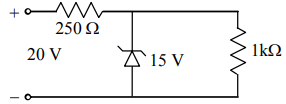In a common-emitter transistor amplifier, the audio signal voltage across the collector is 3 V. The resistance of the collector is 3 k. If the current gain is 100 and the base resistance is 2 k, the voltage and power gain of the amplifier are:
1. 200 and 1000
2. 15 and 200
3. 150 and 15000
4. 20 and 2000
If in a \(\mathrm{p\text-n}\) junction, a square input signal of \(10\) V is applied as shown, then the output across \(R_L\) will be:
| 1. |  |
2. |  |
| 3. |  |
4. |  |
The given graph represents the \(V\text-I\) characteristic for a semiconductor device. Which of the following statement is correct?
| 1. | It is a \(V\text-I\) characteristic for a solar cell where point \(A\) represents open-circuit voltage and point \(B\) represents short-circuit current. |
| 2. | It is for a solar cell and points \(A\) and \(B\) represent open-circuit voltage and current respectively. |
| 3. | It is for a photodiode and points \(A\) and \(B\) represent open-circuit voltage and current respectively. |
| 4. | It is for a LED and points \(A\) and \(B\) represent open-circuit voltage and short circuit current respectively. |
Transfer characteristic [output voltage vs input voltage ] for a base biased transistor in CE configuration is as shown in the figure. For using transistor as a switch, it is used:
1. in region III
2. both in region (I) and (III)
3. in region II
4. in region I
| 1. | \(\mathrm{n}\text-\)type with electron concentration \(n_{e}=5\times10^{22}~\text{m}^{-3}\) |
| 2. | \(\mathrm{p}\text-\)type with electron concentration \(n_{e}=2.5\times10^{23}~\text{m}^{-3}\) |
| 3. | \(\mathrm{n}\text-\)type with electron concentration \(n_{e}=2.5\times10^{10}~\text{m}^{-3}\) |
| 4. | \(\mathrm{p}\text-\)type with electron concentration \(n_{e}=5\times10^{9}~\text{m}^{-3}\) |
A Zener diode, having breakdown voltage equal to \(15\) V, is used in a voltage regulator circuit, as shown in the figure. The current through the diode is:

1. \(10\) mA
2. \(15\) mA
3. \(20\) mA
4. \(5\) mA
For transistor action:
| (a) | the base, emitter and collector regions should have similar size and doping concentrations. |
| (b) | the base regions must be very thin and lightly doped. |
| (c) | the emitter-base junction is forward biased and the base-collector junction is reverse biased. |
| (d) | both the emitter-base junction as well as the base-collector junction are forward biased. |
Which of the following pairs of statements is correct?
1. (d) and (a)
2. (a) and (b)
3. (b) and (c)
4. (c) and (d)
| 1. | the current in the reverse biased condition is generally very small. |
| 2. | the current in the reverse biased condition is small but the forward-biased current is independent of the bias voltage. |
| 3. | the reverse-biased current is strongly dependent on the applied bias voltage. |
| 4. | the forward-biased current is very small in comparison to reverse-biased current. |
The electrical circuit used to get smooth output from a rectifier circuit is called:
1. oscillator.
2. filter.
3. amplifier.
4. logic gates.

| 1. | In the circuit (1) and (2) |
| 2. | In the circuit (2) and (3) |
| 3. | In the circuit (1) and (3) |
| 4. | Only in the circuit (1) |





